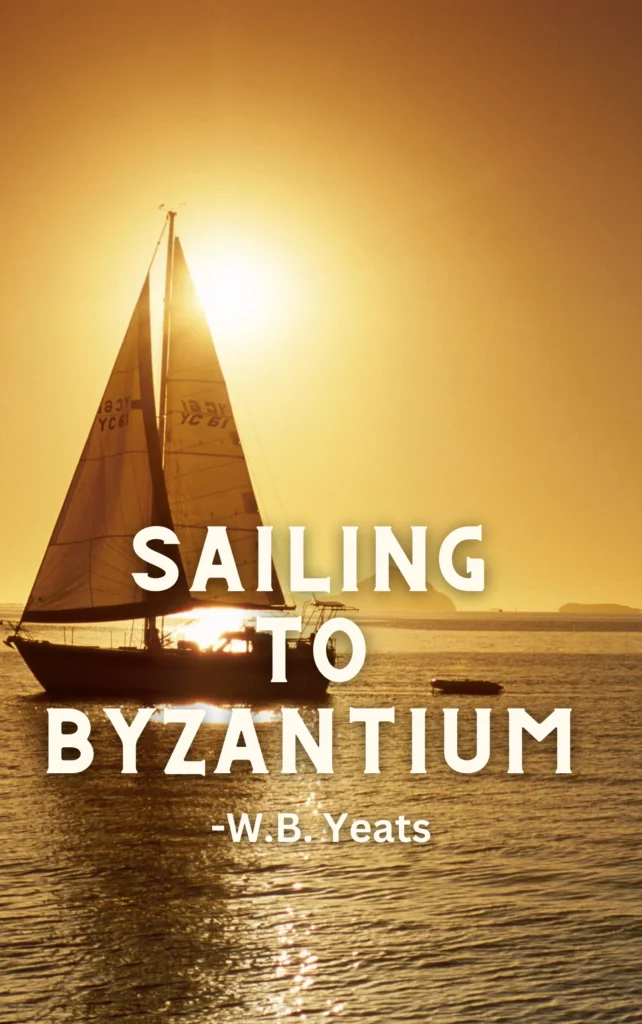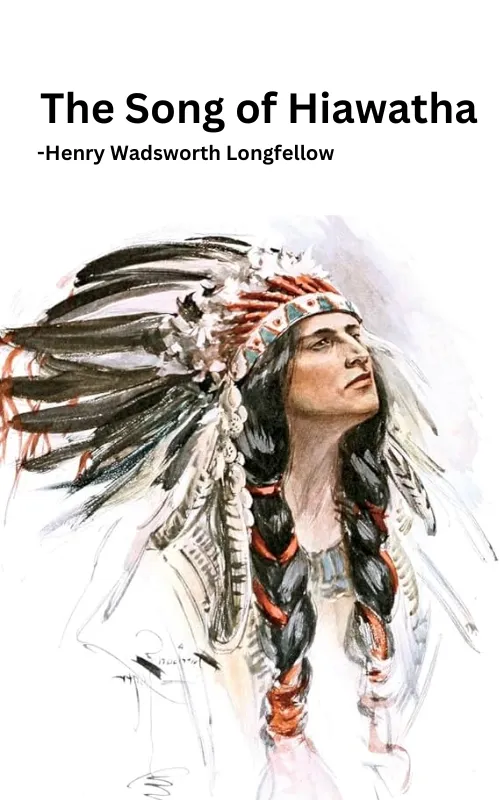
About the Poem-Sailing to Byzantium
| Poem Title | Sailing to Byzantium |
| Author | William Butler Yeats |
| Genre | Lyric poem |
| Publication date | 1928 |
| Speaker | An aging poet |
| Setting | On a ship sailing to Byzantium |
| Subject | The speaker’s desire for eternal life and artistic immortality |
| Themes | Aging, death, immortality, art, beauty |
Themes: Sailing to Byzantium
The themes of the poem “Sailing to Byzantium” are:
- Art and Immortality: The poem reflects on the transience of human life and the desire for immortality through art. Byzantium becomes a symbol of a timeless, artistic realm where the poet seeks to achieve permanence through his crafted works.
- Spiritual Transformation: The poem contemplates a spiritual journey, with the speaker desiring to leave behind the physical decay of old age and achieve a form of rebirth or transformation in the imagined, idealized city of Byzantium.
- Youth and Age: Yeats explores the dichotomy between youth and age, highlighting the limitations of the physical body in old age and the longing for a state of eternal youth that transcends the natural cycle of life.
- Artistic Creation: The act of crafting art is portrayed as a way to transcend the limitations of the mortal body. The poet seeks to transform himself into a mechanical bird, a work of art, to escape the confines of human mortality.
- Cultural Decay and Renewal: The poem reflects on the decay of contemporary society and culture, contrasting it with the idea of Byzantium as a symbol of cultural and artistic excellence. The poet yearns for a place where art and culture thrive eternally.
- Quest for Transcendence: The speaker’s journey to Byzantium represents a quest for transcendence—moving beyond the physical and temporal constraints of earthly existence to achieve a higher, more enduring state.
Literary Devices: Sailing to Byzantium
- Symbolism: The city of Byzantium symbolizes a realm of eternal artistic and intellectual pursuits, contrasting with the ephemeral nature of the natural world.
- Metaphor: The metaphor of a “dying animal” represents the decaying physical body, contrasting with the speaker’s desire for a form of existence beyond mortality.
- Alliteration: The repetition of consonant sounds, such as in “that dolphin-torn, that gong-tormented sea,” adds a rhythmic quality to the poem.
- Imagery: Vivid descriptions of the natural world and mythical elements create a sensory experience for the reader, enhancing the poem’s emotional impact.
- Enjambment: The continuation of a sentence or clause from one line to the next without a pause contributes to the flow of the poem, reflecting the ongoing journey of the speaker.
- Paradox: The concept of becoming a “golden bird” after leaving the natural world is a paradoxical transformation that encapsulates the speaker’s desire for transcendent immortality.
- Synecdoche: The “Grecian goldsmiths” represent the artistic and intellectual achievements of ancient civilizations, emphasizing the speaker’s quest for timeless wisdom and beauty.
- Anaphora: The repetition of the phrase “That is no country for old men” at the beginning of stanzas emphasizes the speaker’s rejection of the physical and temporal constraints of aging.
- Assonance: The repetition of vowel sounds, as in “sages standing in God’s holy fire,” contributes to the musicality of the poem.
- Allusion: The poem alludes to the myth of the Phoenix, reinforcing the theme of spiritual renewal and transformation.
Sailing to Byzantium Poem
That is no country for old men. The young
In one another’s arms, birds in the trees,
—Those dying generations—at their song,
The salmon-falls, the mackerel-crowded seas,
Fish, flesh, or fowl, commend all summer long
Whatever is begotten, born, and dies.
Caught in that sensual music all neglect
Monuments of unageing intellect.
An aged man is but a paltry thing,
A tattered coat upon a stick, unless
Soul clap its hands and sing, and louder sing
For every tatter in its mortal dress,
Nor is there singing school but studying
Monuments of its own magnificence;
And therefore I have sailed the seas and come
To the holy city of Byzantium.
O sages standing in God’s holy fire
As in the gold mosaic of a wall,
Come from the holy fire, perne in a gyre,
And be the singing-masters of my soul.
Consume my heart away; sick with desire
And fastened to a dying animal
It knows not what it is; and gather me
Into the artifice of eternity.
Once out of nature I shall never take
My bodily form from any natural thing,
But such a form as Grecian goldsmiths make
Of hammered gold and gold enamelling
To keep a drowsy Emperor awake;
Or set upon a golden bough to sing
To lords and ladies of Byzantium
Of what is past, or passing, or to come.
Watch Full Poem Summary (Stanza by Stanza)
Sailing to Byzantium Summary & Analysis
Sailing to Byzantium is a celebrated poem written by the renowned Irish poet William Butler Yeats. Composed in 1926 and published in 1928 as a part of his collection “The Tower,” the poem consists of four stanzas. It explores themes of aging, art, and the search for transcendence, drawing upon the contrast between the ephemeral nature of human existence and the timeless realm of art and beauty.
Stanza 1
The poem begins with the speaker addressing the idea of an aging and decaying body. He expresses his desire to escape the physical limitations of old age, referring to the body as “a tattered coat upon a stick” that can no longer fulfill its purpose. The stanza introduces the concept of “singing masters” and the idea of transformation through art, symbolizing the human desire for transcendence.
Stanza 2
In the second stanza, the speaker reflects on the vibrancy of youth, symbolized by the young people gathering and fishing by the sea. However, he sees them as caught in the natural cycles of life and death. He longs for a world where the “dying animal” is not the focus, a place where art and culture are paramount. The idea of “monuments of unageing intellect” represents the enduring creations of human artistry.
Stanza 3
The third stanza deepens the speaker’s desire to leave behind the physical world. He speaks of the “sages” who have transcended the limitations of their physical bodies and have become like “dying embers” in the fire of life. The speaker seeks to be reborn as a golden bird, a symbol of artistic transformation and eternal beauty. He implores the bird to carry him away from the world of natural cycles.
Stanza 4
In the final stanza, the speaker envisions himself in the mythical city of Byzantium, a place of timeless art and intellect. He seeks to be a part of this realm, free from the constraints of the human body, where he can become an integral, singing part of the artifice. He believes that in Byzantium, he can transcend the limitations of mortality and achieve a form of immortality through his art.
FAQs – Sailing to Byzantium
What is the meaning of the poem Sailing to Byzantium?
The poem is about the speaker’s desire for eternal life and artistic immortality.
What is the main theme of Sailing to Byzantium?
The main theme of Sailing to Byzantium is the speaker’s desire for eternal life and artistic immortality.
What is the golden bough in Sailing to Byzantium?
The golden bough in Sailing to Byzantium is a symbol of immortality and artistic immortality.
How is Sailing to Byzantium a highly symbolic poem?
The poem is highly symbolic because it uses a variety of symbols, such as the golden bird, Byzantium, and the gyre, to convey its themes of aging, death, immortality, art, and beauty.
Why does the poet sail to Byzantium and what does Byzantium symbolize?
The poet sails to Byzantium in search of eternal life and artistic immortality.
What is the blood-dimmed tide?
The blood-dimmed tide is a symbol of the violence and chaos of the modern world.
What beast slouches toward Bethlehem?
The beast that slouches toward Bethlehem represents a sense of chaos, decay, and spiritual emptiness in the modern world.











